World
About Andrew Cusack
 Writer, web designer, etc.; born in New York; educated in Argentina, Scotland, and South Africa; now based in London.
Writer, web designer, etc.; born in New York; educated in Argentina, Scotland, and South Africa; now based in London. read more
News
Blogs
Reviews & Periodicals
Arts & Design
World
France
Mitteleuropa
Knickerbockers
Argentina
The Levant
Africa
Cape of Good Hope
Netherlands
Scandinavia
Québec
India
Muscovy
Germany
Academica
A Scene at the Club
Punch, 28 July, 1920
I never liked Buttinbridge. I considered him a vulgar and pushful fellow. He had thrust himself into membership of my club and he had forced his acquaintance upon me.
I was sitting in the club smoking-room the other day when Buttinbridge came in. His behaviour was characteristic of the man. He walked towards me and said in a loud voice, “Cheerioh, old Sport!”
I drew the little automatic pistol with which I had provided myself in case of just such an emergency, took a quick aim and fired. Buttinbridge gave a convulsive leap, fell face downwards on the hearthrug and lay quite still. It was a beautiful shot—right in the heart.
The room was fairly full at the moment, and at the sound of the shot several members looked up from their newspapers. One young fellow—I fancy he was a country member recently demobilised—who had evidently watched the incident, exclaimed, “Pretty shot, Sir!” But two or three of the older men frowned irritably and said, “Sh-sh-sh!”
Seeing that it was incumbent upon me to apologise, I said, in a tone just loud enough to be audible to all present, “I beg your pardon, gentlemen.” Then I dropped the spent cartridge into an ash-tray, returned the pistol to my pocket and was just stretching out my hand to touch the bell when old Withergreen, the doyen of the club, interposed.
“Pardon me,” he said, “I am a little deaf, but almost simultaneously with the fall of this member upon the hearthrug I fancied I heard the report of a firearm. May I claim an old man’s privilege and ask if I am right in presuming a connection between the two occurrences, and, if so, whether there has been any recent relaxation of our time-honoured rule against assassination on the club premises?”
Shouting into his ear-trumpet, I said, “I fired the shot, Sir, which killed the member now lying upon the hearthrug. I did so because he addressed me in a form of salutation which I regard as peculiarly objectionable. He called me ‘Old Sport,’ an expression used by bookmakers and such.”
“Um! Old Port?” mumbled old Withergreen.
“Old Sport,” I shouted more loudly. Then I stepped to the writing-table, took a dictionary from among the books of reference, found the place I wanted and returned to the ear-trumpet.
“I find here,” I said, for the benefit of the room at large, for all were now [pg 75] listening, though with some impatience, “that in calling me a ‘sport’ the deceased member called me a plaything, a diversion. If he had called me a sportsman, which is here defined as ‘one who hunts, fishes or fowls,’ he would have been not necessarily more accurate but certainly less offensive.”
At this point there stood up a member whom I recognised as one of the committee. “I am sure, Sir,” he said, “that all present are agreed that you fired in defence of the purity of English speech, and that the incident was the outcome of an unfortunate attempt to relieve the financial embarrassment of the club by relaxing our former rigorous exclusiveness. Speaking as one of the committee, I have no doubt that the affair will be dismissed as justifiable homicide.”
Having bowed my acknowledgments I rang the bell. When the waiter appeared I bade him “Bring me a black coffee and then clear away the remains of Mr. Buttinbridge.”
Then I was awakened by the voice of Buttinbridge yelling, “Wake up, old Sport!”
‘We Stand By You’
Old Europe Lives?

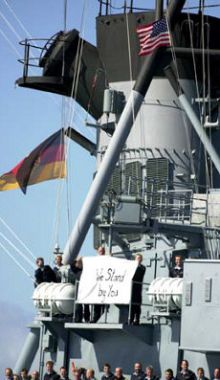 An incident took place at sea on September 14, 2001, just a few days after the attacks on New York and Washington, which has not been widely recounted. In the time leading up to September 11, the U.S.S. Winston S. Churchill was in port in Plymouth, England, where it was moored next to the Lütjens of the German Navy. During their time in port together, the officers and crews of the Churchill and the Lütjens had combined for a number of lively convivial undertakings in the generous spirit of friendship and brotherhood. After the attacks, however, Churchill immediately put to sea to perform a number of drills while maneuvering back in forth in the same area.
An incident took place at sea on September 14, 2001, just a few days after the attacks on New York and Washington, which has not been widely recounted. In the time leading up to September 11, the U.S.S. Winston S. Churchill was in port in Plymouth, England, where it was moored next to the Lütjens of the German Navy. During their time in port together, the officers and crews of the Churchill and the Lütjens had combined for a number of lively convivial undertakings in the generous spirit of friendship and brotherhood. After the attacks, however, Churchill immediately put to sea to perform a number of drills while maneuvering back in forth in the same area.
“It hasn’t been that fun I must confess,” an ensign aboard the Churchill wrote home, “and to be even more honest, a lot of people are frustrated at the fact that they either can’t be home, or we don’t have more direction right now. We have seen the articles and the photographs, and they are sickening. Being isolated as we are, I don’t think we appreciate the full scope of what is happening back home, but we are definitely feeling the effects.”
“About two hours ago the junior officers were called to the bridge to conduct Shiphandling drills. We were about to do a man overboard when we got a call from the Lutjens. […] Now at sea they called over on bridge-to-bridge, requesting to pass us close up on our port side, to say good-bye.”
“We prepared to render them honors on the bridgewing, and the Captain told the crew to come topside to wish them farewell. As they were making their approach, our Conning Officer announced through her binoculars that they were flying an American flag. As they came even closer, we saw that it was flying at half-mast. The bridgewing was crowded with people as the Boatswain’s Mate blew two whistles – Attention to Port – the ship came up alongside and we saw that the entire crew of the German ship were manning the rails, in their dress blues. They had made up a sign that was displayed on the side that read ‘We Stand By You’.”
As the ensign wrote later in the email, “It’s amazing to think that only a half-century ago things were quite different,” and it’s interesting to note that both ships are named after figures from the Second World War; Winston Churchill the half-American Prime Minister of Great Britain, and Günther Lütjens the admired German Admiral who died aboard the Bismarck.

The Neue Galerie

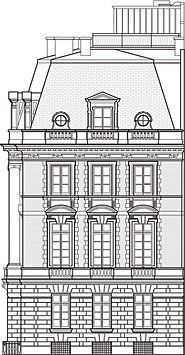 THE RECENT PURCHASE for the Neue Galerie of Gustav Klimt’s 1907 ‘Adele Bloch-Bauer I’ (above), alledgedly for a record-breaking price of $135,000,000, gives me the perfect opportunity to write a post on the eponymously recent addition to New York’s coterie of art museums. Since its 2001 opening, the Neue Galerie has resided in the handsome 1914 beaux-arts mansion on the corner of Fifth Avenue and 86th Street, designed by Carrère and Hastings (of New York Public Library fame) for industrialist William Starr Miller and later inhabited by Mrs. Cornelius Vanderbilt III. In the time since the construction of No. 1048, the rest of Fifth Avenue has undergone a lamentable transformation from a boulevard of beautiful townhouses and mansions to an avenue predominantly consisting of apartment buildings. While one appreciates the inoffensive design of the pre-war buildings on Fifth, there remain a number of thoroughly opprobrious modern interlopers which offend the graceful avenue. One can’t help but pine for Fifth Avenue before the mansions came down, but we can at least give thanks for holdouts like the Neue Galerie. (more…)
THE RECENT PURCHASE for the Neue Galerie of Gustav Klimt’s 1907 ‘Adele Bloch-Bauer I’ (above), alledgedly for a record-breaking price of $135,000,000, gives me the perfect opportunity to write a post on the eponymously recent addition to New York’s coterie of art museums. Since its 2001 opening, the Neue Galerie has resided in the handsome 1914 beaux-arts mansion on the corner of Fifth Avenue and 86th Street, designed by Carrère and Hastings (of New York Public Library fame) for industrialist William Starr Miller and later inhabited by Mrs. Cornelius Vanderbilt III. In the time since the construction of No. 1048, the rest of Fifth Avenue has undergone a lamentable transformation from a boulevard of beautiful townhouses and mansions to an avenue predominantly consisting of apartment buildings. While one appreciates the inoffensive design of the pre-war buildings on Fifth, there remain a number of thoroughly opprobrious modern interlopers which offend the graceful avenue. One can’t help but pine for Fifth Avenue before the mansions came down, but we can at least give thanks for holdouts like the Neue Galerie. (more…)
The Red Lion Coffee Shoppe
Or: How Andrew Cusack Became a Tea Drinker
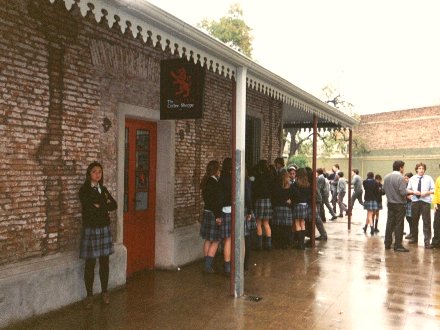
THE HOT SUMMER sun has fled us here in New York, having been replaced by the cooling but somber clouds of rain. My mind can’t help but harken back to an August of just a few years ago when I spent the summer in Argentina. Of course, New York’s summer is Buenos Aires’s winter, but in Argentina winter means prodigious rain and skies of grey, rather than the glorious snows we’re used to in the Big Apple. On the grounds of St. Alban’s College, our happy little school, there was situated the spartan but merry Red Lion Coffee Shoppe.
On many a cold, grey, Argentine August day we would escape the sufferings of education and flee to the Red Lion. There were two points of service at the Red Lion coffee shop: one a window which faced onto the outside (seen above), the other a hole-in-the wall counter which faced onto the little square room which was the shop. It was a simple, sparsely-decorated room with a few chairs and tables, the walls covered with posters lauding South African rugby and New Zealand cricket, and framed prints depicting charming views of other St Alban’s toponyms around the world: the original St. Alban’s in England, St. Alban’s in South Africa, St. Alban’s in Denmark, St. Alban’s just about everywhere. There was only one heater (the Argentines, in their desire to be in all ways like the British, do not heat their buildings properly) mounted onto the side wall opposite the counter and the obvious idea was to sit right next to the heater or else freeze. It was a black moment when one entered the Red Lion only to discover that others – the nerve! – were already situated by the heater. Rest assured, many a rueful glance was exchanged.
Anyhow, while a number of carbonated beverages were on offer, a nice warm cup of tea was much preferred to a cold, refrigerated soda. Tea at the Red Lion, which was invariably Green Hills, was accompanied by chocolate, usually fulfilled by a packet of M&M’s, but occasionally I went for Rhodesia bars which I confess I only ever bought because of their name. (Incidentally, I took a Rhodesia bar home and when I had a fetching young tutor at St Andrews who was one of the last Rhodesians to be born, I gave it to her as a gift at our last tutorial).
I had never been a regular tea drinker before then and am very glad that I acquired the happy habit; it is one which has stood me well throughout the ages. What better companion in Scotland, for example, while reading as the grey tempest of the Caledonian climate brews outside, than a nice cup of warm brew inside? And of course tea need not be a solitary joy. When I think of the hours wasted away in after-rosary cups of tea on weekday afternoons in St Andrews! It would bring scandal to some. Indeed one cold Scottish afternoon the hours of cups of tea gave way to two bottles of port, and then a raid by a gaggle of ne’erdowells on my secret whiskey reserve! (Duly recounted herein).
At any rate, I believe it to be one of summer’s chief deficiencies that it is too hot for the proper, frequent enjoyment of tea, and so I rather look forward to the coming fall and winter seasons. Nestled in a comfy chair with a nice cup of tea and a good book; could there be pleasures more sublime?
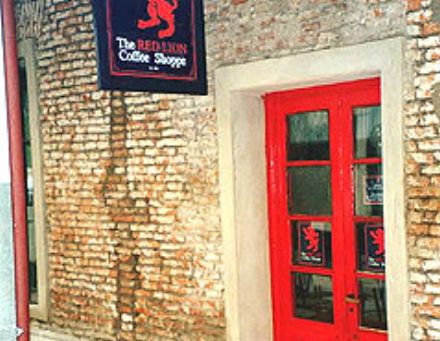
‘Villiers Prepares His Offensive’

Philippe de Villiers is preparing his campaign for the 2007 presidential election, Le Figaro recently reported, after having conducted an informal tour of holiday spots around France to bring his candidacy to vacationing voters. As the articles notes, one of the most important challenges for de Villiers and his Mouvement pour la France (MPF) is carving out a niche in the media for his campaign. Press coverage of the 2007 competition has portrayed the election as a showdown between the Socialist Party’s Ségolène Royal and the UMP’s Nicolas Sarkozy, a lack of fundamental differences between the two candidates on the major issues notwithstanding.
Despite a number of recent high-ranking defections to the MPF from the populist/nationalist Front National, the party which usually takes third place after the UMP and the Socialists, it’s unknown whether a significant portion of the Front‘s electoral base with follow through and vote for de Villiers instead of the FN’s Jean-Marie Le Pen. During last year’s referendum on the EU constitution, de Villiers swept the rug from under Le Pen’s feet by masterfully organizing the right wing of the successful ‘No’ campaign himself. If the Vendéen can repeat such a performance and seize the electoral momentum from the misanthropic FN leader, there’s a chance of both making it to the second electoral round and putting the ugly spectre of Le Penisme in its grave.
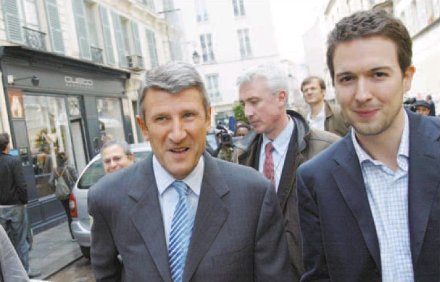
Le Figaro: Philippe de Villiers will carry out a tour of France this fall with MPF secretary-general Guillaume Peltier.
In an interview with le Figaro, the MPF’s second-in-command Guillaume Peltier proclaimed that “France needs a candidate who personifies the real Right and who will commit the country to a break with socialism”. When asked about the MPF’s policy on the impôt sur la fortune (ISF) tax on wealth, Peltier refreshingly replied “We propose its repeal, pure and simple”.
“The ISF strikes great fortunes less and less while striking middle-class homeowners more and more,” Peltier claimed. “Because of real estate prices are on fire, one finds farmers who do not even qualify to pay income tax who are stuck with the ISF. The UMP, with the capability for four years, has not done anything to end this unjust situation.”
And Europe? “Instead of an incomprehensible constitution, we propose a European charter on three points: 1) A truly European Europe, without Turkey; 2) A democratic Europe directed by the parliaments and by the peoples, and not by the technocrats of Brussels; and 3) A Europe of free cooperation against terrorism, drug trafficking, and organised crime.” The MPF would also support a referendum on whether to continue France’s participation in the Euro monetary union.
And finally, his prediction for 2007: “I consider that Philippe de Villiers will be in 2007 what the ‘Non’ was in 2005. Villiers is the only candidate of rural France, the candidate of the France of common sense. I’m persuaded he can make it to the second round. I see a Villiers/Royal run-off, the real Right against the real Left.”
Previously: On Walkabout with Philippe de Villiers
The Farm Killings of South Africa
The above video is a ten-minute portion of a South African news programme exploring the brutal killings of innocent farmers in that country. It is most certainly worth watching, with the caveat that it’s not for the faint of heart. It is astonishing that people can live in such a climate of violence and fear. “But with the Lord’s strength, I’m here,” says one victim.
Even more appalling once you’ve watched that video is to watch the video below of South Africa’s Safety and Security Minister, Charles Nqakula, attacking those who complain about the rise in rape and murder. “They can continue to winge until they are blue in the face, they can continue to be as negative as they want to or they can simply leave this country.” It doesn’t take a genius to understand that the ‘they’ he speaks of is the community of white South Africans. Plus ça change, eh?
Further along the theme of South African online videos, why not watch the trailer for the upcoming film ‘Catch A Fire’? Soon to be released by Focus Features, the film tells the true story of Patrick Chamusso, a man brutally tortured by the police while falsely accused of terrorism. He is freed when they realize he is innocent, but soon makes up for his innocence by, you guessed it, becoming a terrorist.
Racialist Thinking Behind the Times
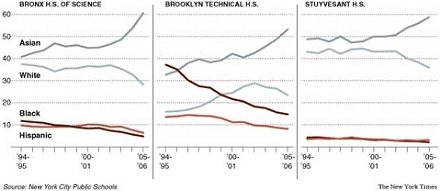
The fair-minded, independent observer would look at the figures above and think to himself “Interesting, the proportion of Asian students is on the rise, while that of White, Black, and Hispanic students is generally in decline”. However the racialists (I will not use the more loaded term of ‘racist’, though the meaning is exactly the same) at the New York Times can only see the Black and Hispanic decline, captioning the chart ‘The share of black and Hispanic students New York City’s three most elite specialized schools has declined’.
And why no chart depicting the racial make-up of the also public selective Hunter College High School? Is it, by some unknown criterion, not in the same league or perhaps the proportion of black and Hispanic students there actually rose? The Times reader is left uninformed as to the greater picture, but suitably inculcated in racialist thinking.
Gothamist’s Jen Chung notes the decline is “in spite of the city’s best efforts to encourage [Black and Hispanic students] to apply and attend” while City Councilman Robert Jackson ponders “”Is it institutional racism or is it something else?”.
Could it perhaps be that the racial makeup of the city’s elite public high schools is subject to (quel horreur!) occasional fluctuations? What is the racial makeup of an elite public high school “supposed” to be? Here’s a concept worth considering: how about giving the students in selective public high schools the best education on offer and admit students based purely on a meritocratic standard which does not descriminate by sex, race, class, or creed? Just a thought.
Two Scotsmen
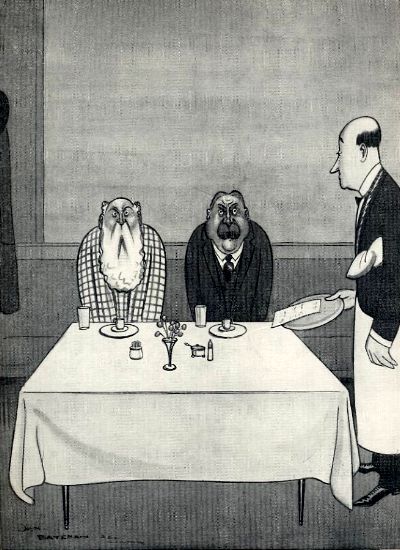
THE ORIGIN OF THE SLOW MOTION PICTURE
Study of two Scotsmen, having dined together, reaching for the bill.
H.M. Bateman
The Haunting Richardsonian
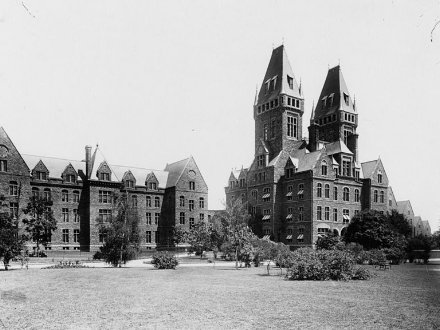
ONE OF THE splendid things about New York is that it’s a land which continually manages to throw up a surprise or two, even to time-hardened devotées of all things knickerbocker such as yours truly. One of my most recent discoveries is the fabulously haunting and impressive Buffalo State Hospital out in the far west of the Empire State.
The magnificent building was built to the design of Henry Hobson Richardson, the progenitor of the eponymous ‘Richardsonian Romanesque’ style, as one of a series of governmental asylums for the insane founded throughout the nineteenth century. Richardson also did a great deal of work on the Capitol in Albany, designing the south façade which, since the construction of Nelson Rockefeller’s Little Brasilia, is now the main façade of the building and was inspired by the Hôtel de Ville in Paris.
Construction on the State Hospital began in 1870, and the central administration block with its two towers and a number of flanking pavilions housing patients were opened in 1880. Interestingly, the towers which so dominate the building are purely decorative and remain unfinished on the interior.
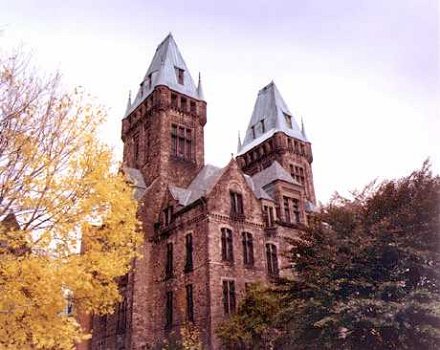
The footprint of the building follows the V-shaped Kirkbride plan, conceived by Pennsylvania’s Dr. Thomas Story Kirkbride in his 1854 opus, On the Construction, Organization and General Arrangements of Hospitals for the Insane which revolutionized care for the mentally unstable in the nineteenth century. The location was a 100-acre parcel of property near the city of Buffalo, and the grounds were landscaped by Frederick Law Olmsted, who designed Central Park with Calvert Vaux.
The grounds originally included farms which helped to feed the patients and staff, but in the 1920’s this land was redeveloped as the Buffalo State College, now the University at Buffalo (State University of New York). The hospital, renamed Buffalo Psychiatric Center, moved out of the Richardsonian complex into a plain, ugly, modern building on the grounds in the 1960’s, leaving the beautiful Victorian structure to rot and ruin.
However recent efforts by Buffalo and New York state officials have led to the replacement of the roof and other work to ensure the continued integrity of the building. The latest plans would have the building serve an educational function under the auspices of the State University next door, an appropriate purpose for this majestic gem of New York architecture.
Avenida de Mayo, Buenos Aires
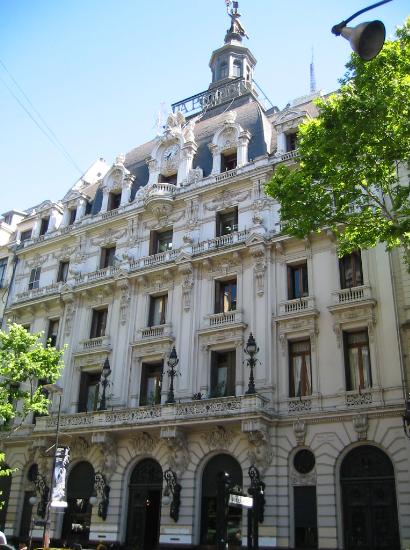
The La Prensa building, formerly home to the newspaper of that name, now the Casa de Cultura.
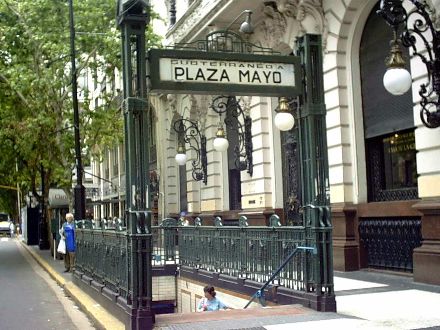
The subte entrance in front of the edificio La Prensa.
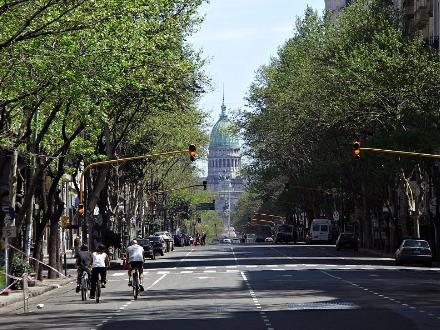
Looking down the Avenida toward the Palacio del Congreso.
On Walkabout with Philippe de Villiers

Viscount Philippe le Jolis de Villiers de Saintignon is the head of the French political party Mouvement pour la France, and one of the leading voices against the Islamisation of France. The MPF is, in some sense, the ‘Catholic’ party on the French right, being conservative and traditionalist in contrast to the Front National (headed by the genial misanthrope Jean-Marie le Pen), which is thoroughly republican and nationalist. De Villiers has been trying to encourage patriotism in contrast to the nationalism of the FN and the continentalism of the other parties.
A native of the Vendée, he led the right flank (so to speak) in the May 2005 French referendum against the European Constitution. The rejection of the Constitution by the French voters has put the nefarious project on hold, though likely not for long. (The established precedent with European treaties of this nature is for the ruling bureaucratic elite to hold as many referenda as it takes to pass). Let’s follow le bon vicomte and see what he’s up to these days…
Stauffenberg’s Arms
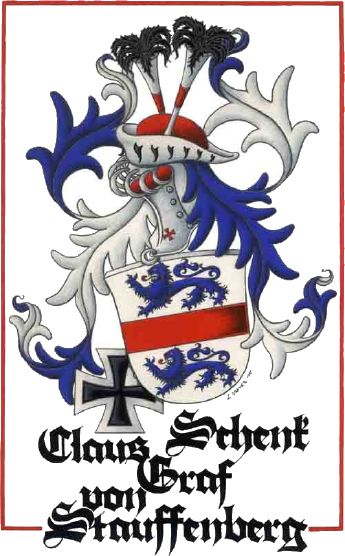
Hommage à la mémoire de Claus Philip Maria Schenk comte von Stauffenberg, homme d’honneur et de foi, qui participa à l’attentat contre Hitler, le 20 juillet 1944 dans le cadre du plan ‘Walkyrie’ destiné à renverser le régime nazi.
The arms of Claus Philipp Maria Schenk Count von Stauffenberg, beautifully depicted by the French heraldic artist Laurent Granier.

Previously: Long Live Our Holy Germany!
New York in Philately
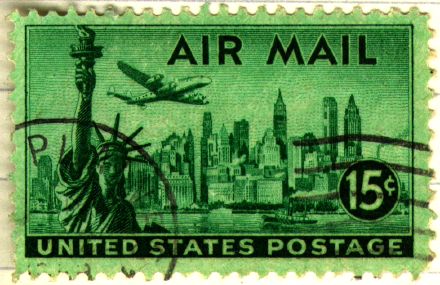
Wandering around the merry old world wide web I stumbled upon these stamps, which I bring to you for your own enjoyment. Above we have the Great Metropolis itself, the island of Manhattan in its swankier days. Below we have a view of the Crown of the Hudson, West Point, with the beautiful Cadet Chapel designed by that American Master, Bertram Grosvenor Goodhue himself, presiding over the campus of the United States Military Academy.
The postage stamp was once a thing of beauty and composition, but it’s heartening to see that some still design beautiful stamps. Just examine Elliott Banfield’s stamp of General Washington, based upon the staute in Union Square. Mr. Banfield believes that the decline in the design of postage stamps is due to a “moral void” most readily shown when the Postal Service unveiled its famous ‘Elvis Stamp’ a few years back.
“Elvis was important in the popular culture, yes,” writes Mr. Banfield. “But how important is the pop culture? Important only to those who can’t see anything higher or better. It’s scary to think that people like that are in charge of public policy. But they are, and the Elvis stamp proves it.”
Hear! Hear!
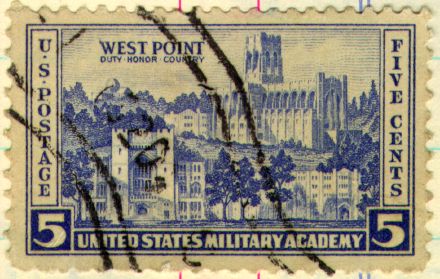
An irrelevant stamp, after the jump.
Can Kid Save This Sinking Ship?
25-Year-Old Buys the Salmon Siren of the Upper East Side
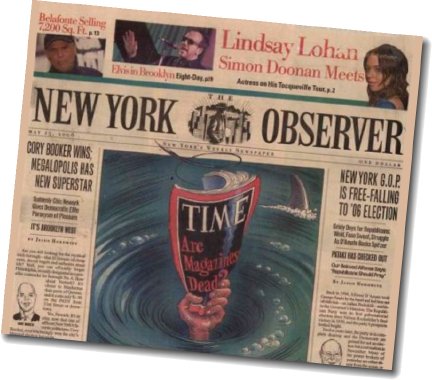
AN NYU LAW  student of just twenty-five years of age has purchased the majority stake in the New York Observer. Jared Kushner (right), son of the currently jailed big-time donor to the New Jersey Democrats Charles Kushner, bought the biggest-piece-of-the-pie off of publisher Arthur Carter, who founded the insouciant weekly printed on salmon-tinted paper back in 1988. No official word on how much money changed hands during the deal, though the Times cites “one person familiar with details of the sale” claiming the amount was nearly $10 million. Carter will maintain a significant say in the paper’s operations, and there are no plans to make any changes to the masthead as of the moment. Earlier in the year Robert de Niro was in talks to buy the Observer through his Tribeca Film Festival operation, but the negotiations fell through.
student of just twenty-five years of age has purchased the majority stake in the New York Observer. Jared Kushner (right), son of the currently jailed big-time donor to the New Jersey Democrats Charles Kushner, bought the biggest-piece-of-the-pie off of publisher Arthur Carter, who founded the insouciant weekly printed on salmon-tinted paper back in 1988. No official word on how much money changed hands during the deal, though the Times cites “one person familiar with details of the sale” claiming the amount was nearly $10 million. Carter will maintain a significant say in the paper’s operations, and there are no plans to make any changes to the masthead as of the moment. Earlier in the year Robert de Niro was in talks to buy the Observer through his Tribeca Film Festival operation, but the negotiations fell through.
The Observer, with a small-but-influential circulation of 55,000, has undergone a miniature transformation recently with the hopes of turning around the current losses of about $2 million a year. The most noticeable of these changes came in May when the paper trimmed over an inch in width, moving from six front-page columns to five and giving it a taller, more narrow appearance. While the thinner size saves on rising newsprint costs it also means diminished space for advertising, and the newspaper lost its easy, leisurely feel, also moving from two sections to one. The Observer has also increased the volume of its internet operations on Observer.com, some might say at the expense of the quality of the printed edition. The new owner, however, will take a back seat in the content of the newspaper while concentrating on improving the bottom line, citing the Observer‘s strong brand despite its current financial woes.
Kushner’s father, a well-known New Jersey real estate developer, was sentenced to a jail term last year after being found guilty of tax evasion, and is well-known for a number of other stunts which do not bear repeating on, er, family-friendly sites such as this. The younger Kushner himself has given over $100,000 to various (Democratic) political outfits since 1992, when he was a mere eleven years of age.
I used to read the Observer often (though not regularly) because it had the most style of all the New York newspapers. While its flighty spirit meant it lacked a certain depth, it still had zing and usually at least a handful of interesting articles each week. The quality of the content began slipping, however, and when I came home to New York I bought one copy while waiting for the train in Grand Central, was completely dissatisfied like the new size and feel, and decided to give it up. I will always have a certain fondness for the Observer though; in the age when Gannett-style corporate monotony is king, it has managed to maintain a certain classic swankiness (epitomised in its reporter-and-skyline emblem) and for that we can be grateful.
Dr. Strangelove & Dr. Timmerman
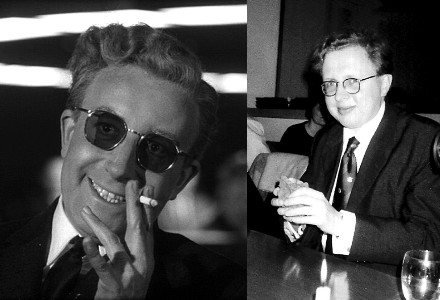
I’ve always had suspicions about my friend Dr. Jens Timmerman, a Göttingen/Balliol man and the Frankfurter Allgemeine Zeitung‘s only subscriber in the Royal Burgh of St Andrews. He clearly has some Strangelovian blood in his veins.
One of the best things about Jens (apart from being a man of erudition and taste) is his refusal to give in to the low standard of propriety maintained by students; especially the practice of arriving for his lecture, picking up the handout, and leaving immediately. One day he made a fake handout and waited for the lazybones to leave before distributing the real handout to the remnant. It included, under ‘Further Reading’, a guide to manners and etiquette. Also, I am informed that whenever a mobile phone goes off during one of his lectures he pronounces “Please turn off your walkie-talkies!”
An Old Military Academy on Long Island
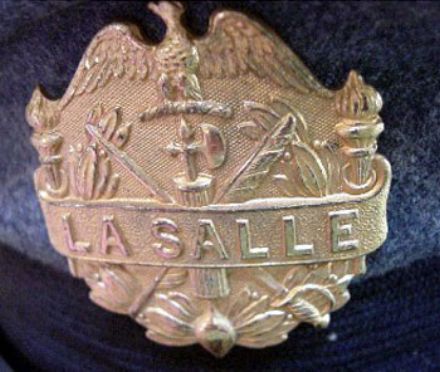
EDUCATION HAS BEEN one of the long-standing traditions of the Christian faith, as has service, and what better expression of education and service is there than the Catholic military school. La Salle Military Academy in Oakdale, L.I. was just one of these institutions, founded by the de la Salle Christian Brothers in 1883. The school was actually founded here in Westchester as the Westchester Institute, but moved in 1926 to Indian Neck Hall on Long Island, built by F.G. Bourne (whose upsate shack was Singer Castle on Dark Island) and once one of the largest estates on the Island. The main building was a 110-room mansion overlooking Great South Bay, designed by Ernest Flagg who, coincidentally, was responsible much of the Naval Academy at Annapolis including the great chapel which contains the tomb of John Paul Jones, sometime admiral of the United States and Imperial Russian navies. (more…)
An Old Boathouse in Spuyten Duyvil
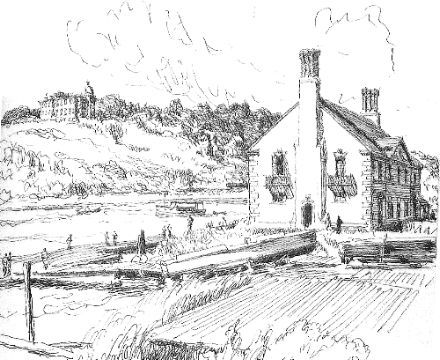
Flipping through an old book called ‘Magical City: Intimate Sketches of New York’, I came upon this sketch of the Gould Boathouse of Columbia University on the Harlem River by Spuyten Duyvil. I had never come across this little building before and had significant doubts as to whether it was still there, but to my pleasant surprise it does. I’m afraid I don’t know much about the boathouse nor its history, but here follows a number of photos and images of it, and of various Columbia boathouses of the past. (more…)
Politician Mentions Chesterton
Hold the Front Page!
 The Canadian Prime Minister, the Rt. Hon. Stephen Harper PC MP, has moved higher in my estimations since I read the transcript of his speech given this past Friday to the Canada-U.K. Chamber of Commerce. The Prime Minister recalled the words of Sir Winston Churchill speaking in Ottawa in 1929 that at the heart of the relationship between Canada and the United Kingdom “is the golden circle of the Crown which links us all together with the majestic past that takes us back to the Tudors, the Plantagenets, the Magna Carta, habeas corpus, petition of rights, and English common law… all those massive stepping stones which the people of the British race shaped and forged to the joy, and peace, and glory of mankind.”
The Canadian Prime Minister, the Rt. Hon. Stephen Harper PC MP, has moved higher in my estimations since I read the transcript of his speech given this past Friday to the Canada-U.K. Chamber of Commerce. The Prime Minister recalled the words of Sir Winston Churchill speaking in Ottawa in 1929 that at the heart of the relationship between Canada and the United Kingdom “is the golden circle of the Crown which links us all together with the majestic past that takes us back to the Tudors, the Plantagenets, the Magna Carta, habeas corpus, petition of rights, and English common law… all those massive stepping stones which the people of the British race shaped and forged to the joy, and peace, and glory of mankind.”
The Prime Minister continued: “Britain gave Canada all that – and much more. Including: Parliamentary democracy; a commitment to basic freedoms; the industrial revolution; and the entrepreneurial spirit and free market economy. Not to mention Shakespeare, Dickens, Kipling, Lewis, and Chesterton.”
Chesterton! How splendid to hear a politician, not to mention a head of government – an American head of government (North American, if you insist) – include G.K. Chesterton as one of the precious gifts of the Mother Country to her far-flung children in the English-Speaking World.
Previously: Dilbert on Gilbert | Chesterton Remembered
Marshal Foch and the Old Guard
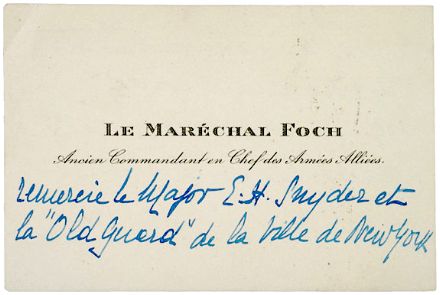
This calling card of Marshal Ferdinand Foch, Supreme Allied Commander during the First World War, was for sale in November of 2005. The text reads Le Maréchal Foch, Ancien Commandant en Chef des Armées Alliées, remercie le Major E.H. Snyder et la “Old Guard” de la Ville de New York or, in English, “Marshal Foch, Former Commander in Chief of the Allied Armies, thanks Major E.H. Snyder and the Old Guard of the City of New York”.
Previously: A New York Funeral | Old Guardsmen | The Old Guard | Grandpa
The Veteran Corps of Artillery
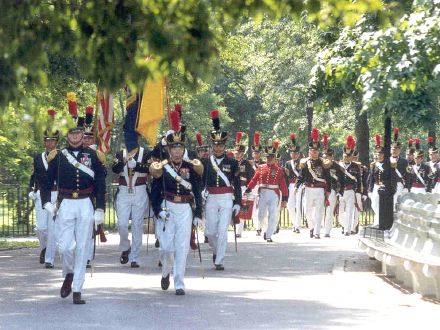
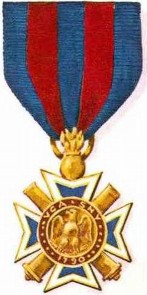 I PROMISED MYSELF I’d wake up this 4th of July morning and head down to the Battery for the annual Independence Day artillery salute by the Veteran Corps of Artillery. However, the gods of slumber ordained that I remain in bed asleep and so in recompense I thought I’d bring you, dear readers, an informative post about the Corps itself. While this site has featured a fair amount on the Old Guard we mustn’t let our readers be mistaken that we are somehow ignoring the VCA. After all, the Veteran Corps of Artillery, State of New York, founded in 1790, is more senior to the Old Guard, founded in 1826 (though in fact an amalgamation of the two older militia companies, if I recall correctly). While there is more of the Old Guard available from online research, I am more familiar with the VCA owing to my Uncle Matt’s membership thereof. And of course, like the Old Guard, the VCA operates on a seperate ranking structure, so that one could be a Major General in the Army, National Guard, or New York Guard, and yet be a mere private in the Veteran Corps of Artillery. (more…)
I PROMISED MYSELF I’d wake up this 4th of July morning and head down to the Battery for the annual Independence Day artillery salute by the Veteran Corps of Artillery. However, the gods of slumber ordained that I remain in bed asleep and so in recompense I thought I’d bring you, dear readers, an informative post about the Corps itself. While this site has featured a fair amount on the Old Guard we mustn’t let our readers be mistaken that we are somehow ignoring the VCA. After all, the Veteran Corps of Artillery, State of New York, founded in 1790, is more senior to the Old Guard, founded in 1826 (though in fact an amalgamation of the two older militia companies, if I recall correctly). While there is more of the Old Guard available from online research, I am more familiar with the VCA owing to my Uncle Matt’s membership thereof. And of course, like the Old Guard, the VCA operates on a seperate ranking structure, so that one could be a Major General in the Army, National Guard, or New York Guard, and yet be a mere private in the Veteran Corps of Artillery. (more…)
Search
Instagram: @andcusack
Click here for my Instagram photos.Most Recent Posts
- Amsterdam November 26, 2024
- Silver Jubilee November 21, 2024
- Articles of Note: 11 November 2024 November 11, 2024
- Why do you read? November 5, 2024
- India November 4, 2024
Most Recent Comments
Book Wishlist
Monthly Archives
Categories


